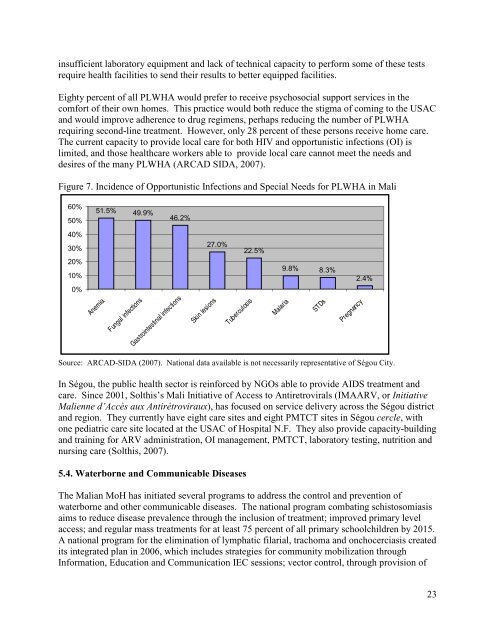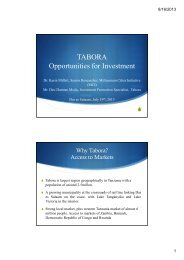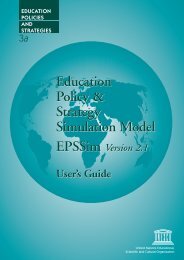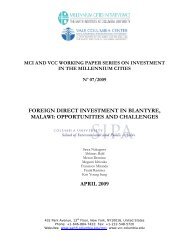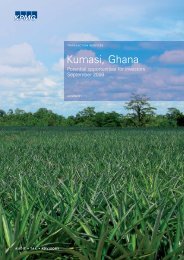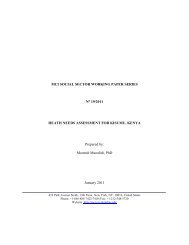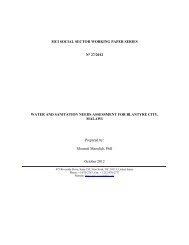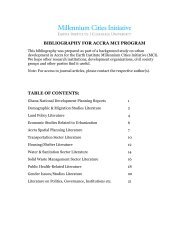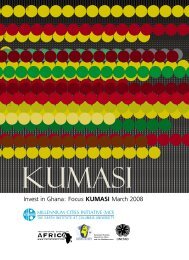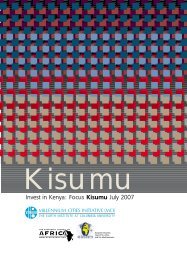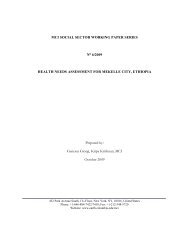Health Needs Assessment for the City of Segou, Mali - Millennium ...
Health Needs Assessment for the City of Segou, Mali - Millennium ...
Health Needs Assessment for the City of Segou, Mali - Millennium ...
Create successful ePaper yourself
Turn your PDF publications into a flip-book with our unique Google optimized e-Paper software.
insufficient laboratory equipment and lack <strong>of</strong> technical capacity to per<strong>for</strong>m some <strong>of</strong> <strong>the</strong>se tests<br />
require health facilities to send <strong>the</strong>ir results to better equipped facilities.<br />
Eighty percent <strong>of</strong> all PLWHA would prefer to receive psychosocial support services in <strong>the</strong><br />
com<strong>for</strong>t <strong>of</strong> <strong>the</strong>ir own homes. This practice would both reduce <strong>the</strong> stigma <strong>of</strong> coming to <strong>the</strong> USAC<br />
and would improve adherence to drug regimens, perhaps reducing <strong>the</strong> number <strong>of</strong> PLWHA<br />
requiring second-line treatment. However, only 28 percent <strong>of</strong> <strong>the</strong>se persons receive home care.<br />
The current capacity to provide local care <strong>for</strong> both HIV and opportunistic infections (OI) is<br />
limited, and those healthcare workers able to provide local care cannot meet <strong>the</strong> needs and<br />
desires <strong>of</strong> <strong>the</strong> many PLWHA (ARCAD SIDA, 2007).<br />
Figure 7. Incidence <strong>of</strong> Opportunistic Infections and Special <strong>Needs</strong> <strong>for</strong> PLWHA in <strong>Mali</strong><br />
60%<br />
50%<br />
40%<br />
30%<br />
20%<br />
10%<br />
0%<br />
51.5% 49.9%<br />
Anemia<br />
Fungal infections<br />
46.2%<br />
Gastrointestinal infections<br />
27.0%<br />
Skin lesions<br />
Tuberculosis<br />
Source: ARCAD-SIDA (2007). National data available is not necessarily representative <strong>of</strong> Ségou <strong>City</strong>.<br />
In Ségou, <strong>the</strong> public health sector is rein<strong>for</strong>ced by NGOs able to provide AIDS treatment and<br />
care. Since 2001, Solthis’s <strong>Mali</strong> Initiative <strong>of</strong> Access to Antiretrovirals (IMAARV, or Initiative<br />
<strong>Mali</strong>enne d’Accès aux Antirétroviraux), has focused on service delivery across <strong>the</strong> Ségou district<br />
and region. They currently have eight care sites and eight PMTCT sites in Ségou cercle, with<br />
one pediatric care site located at <strong>the</strong> USAC <strong>of</strong> Hospital N.F. They also provide capacity-building<br />
and training <strong>for</strong> ARV administration, OI management, PMTCT, laboratory testing, nutrition and<br />
nursing care (Solthis, 2007).<br />
5.4. Waterborne and Communicable Diseases<br />
22.5%<br />
9.8% 8.3%<br />
The <strong>Mali</strong>an MoH has initiated several programs to address <strong>the</strong> control and prevention <strong>of</strong><br />
waterborne and o<strong>the</strong>r communicable diseases. The national program combating schistosomiasis<br />
aims to reduce disease prevalence through <strong>the</strong> inclusion <strong>of</strong> treatment; improved primary level<br />
access; and regular mass treatments <strong>for</strong> at least 75 percent <strong>of</strong> all primary schoolchildren by 2015.<br />
A national program <strong>for</strong> <strong>the</strong> elimination <strong>of</strong> lymphatic filarial, trachoma and onchocerciasis created<br />
its integrated plan in 2006, which includes strategies <strong>for</strong> community mobilization through<br />
In<strong>for</strong>mation, Education and Communication IEC sessions; vector control, through provision <strong>of</strong><br />
Malaria<br />
STDs<br />
2.4%<br />
Pregnancy<br />
23


